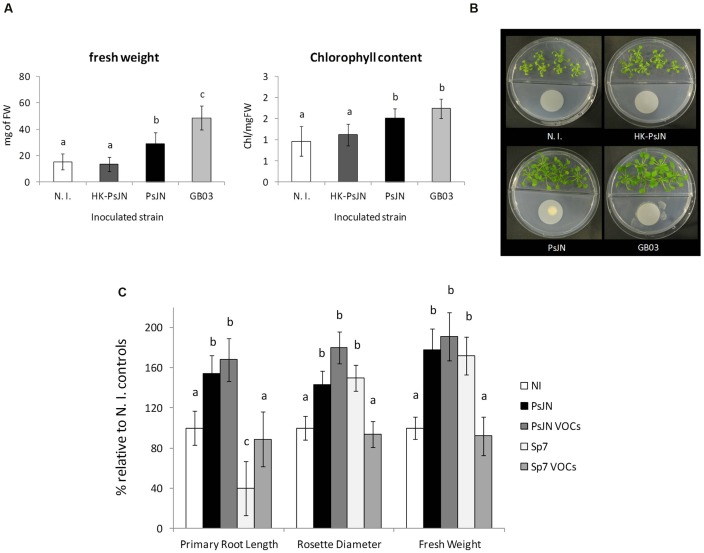FIGURE 2.
Bacterial stimulation of A. thaliana growth mediated by volatile organic compounds (VOC) from P. phytofirmans PsJN. The effects of bacterial emission of volatile compounds was tested using divided petri dishes with A. thaliana col-0 plants sown in half strength MS medium agar on one side, and minimal medium for bacterial growth on the other. 1 × 106 CFU of the corresponding bacterial inoculum (N. I.; PsJN; HK-PsJN; or Bacillus sp. strain GB03) was added on top of a 0.022 μm filter. Total fresh weight and chlorophyll content per mg of fresh tissue were measured at 21 DAS. Columns show mean values, while error bars indicate standard deviations for 30 plants (fresh weight) or 6 plants (chlorophyll content) (A, left and center panels). Different letters indicate statistically significant differences among bacterial treatments (One-way ANOVA, p < 0.05). Representative photographs of plates are presented for each bacteria treatment (B). Root growth, rosette diameter and fresh weight of A. thaliana (C) directly inoculated with 1 × 104 CFU/ml of strain PsJN (PsJN), 1 × 104 CFU/ml of A. brasilense strain Sp7 (Sp7), or co-incubated separately with each of these strains in dual plate systems (PsJN VOCs or Sp7 VOCs, respectively). Growth parameters were registered at 21 DAS. Bars show mean percentage values relative to N. I. plants, and the error bars indicate standard deviations from experiments with 24 plants analyzed for each bacterium and salt treatment. Different letters indicate statistically significant differences among bacterial treatments within each salt concentration for each measured parameter (One way ANOVA Tukey’s HSD tests; p < 0.05).

